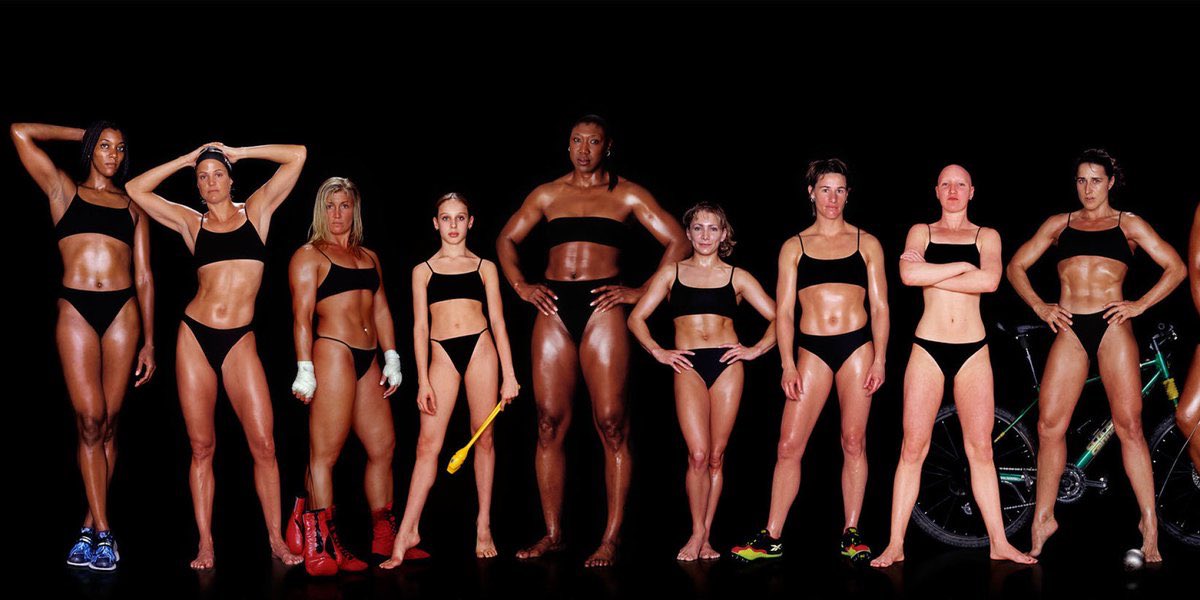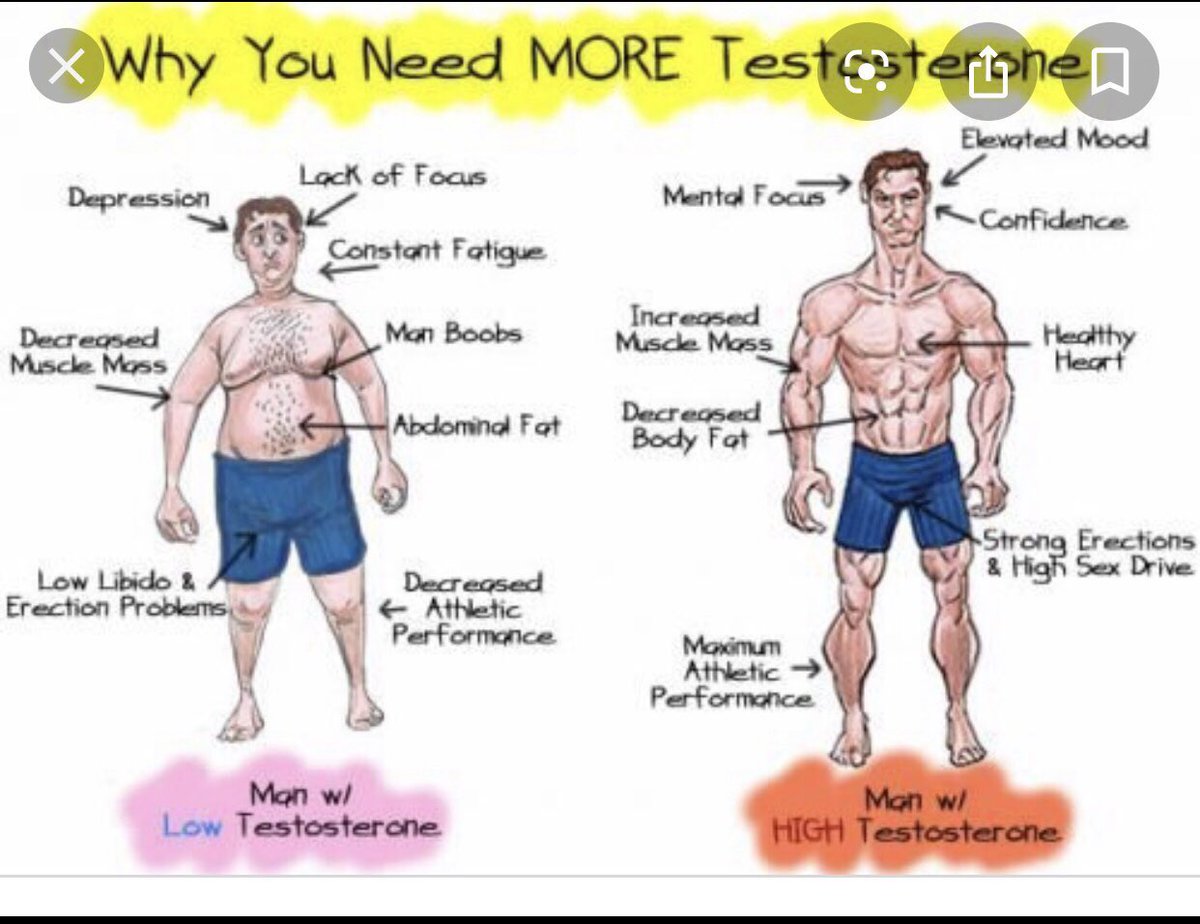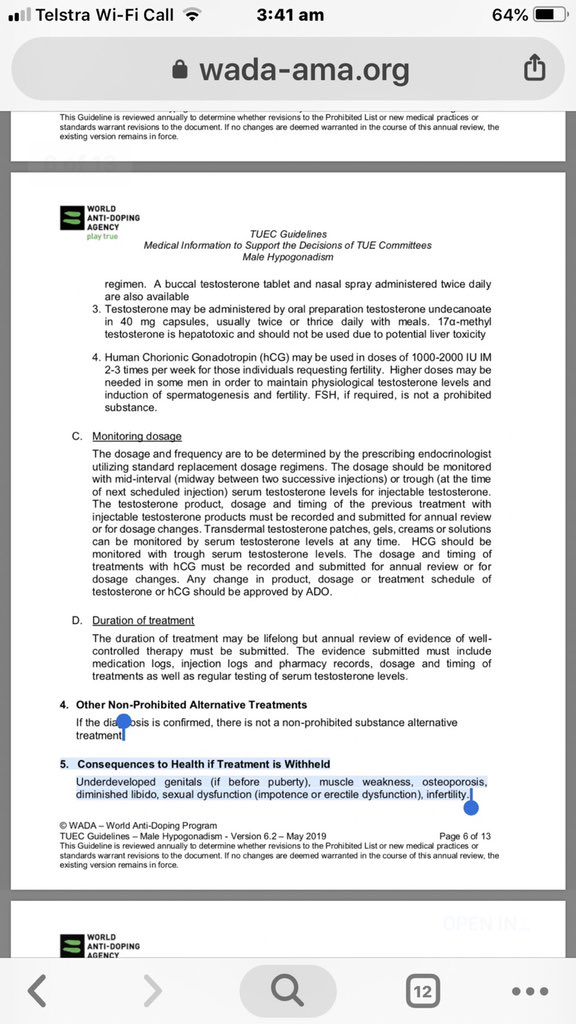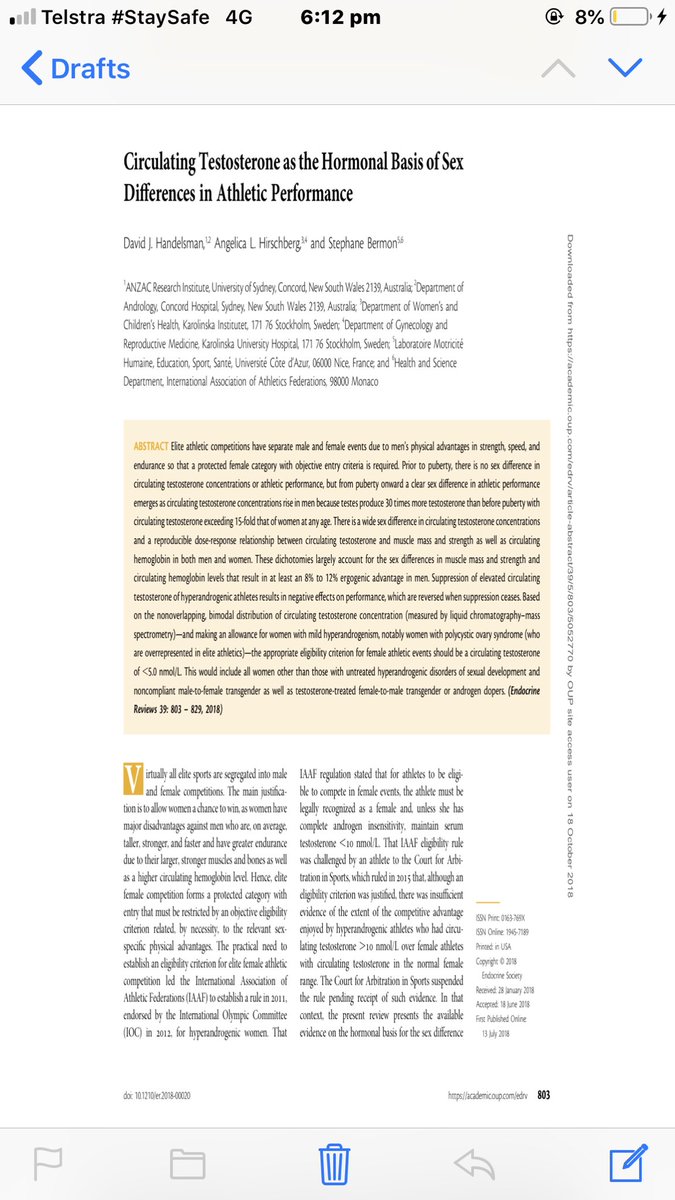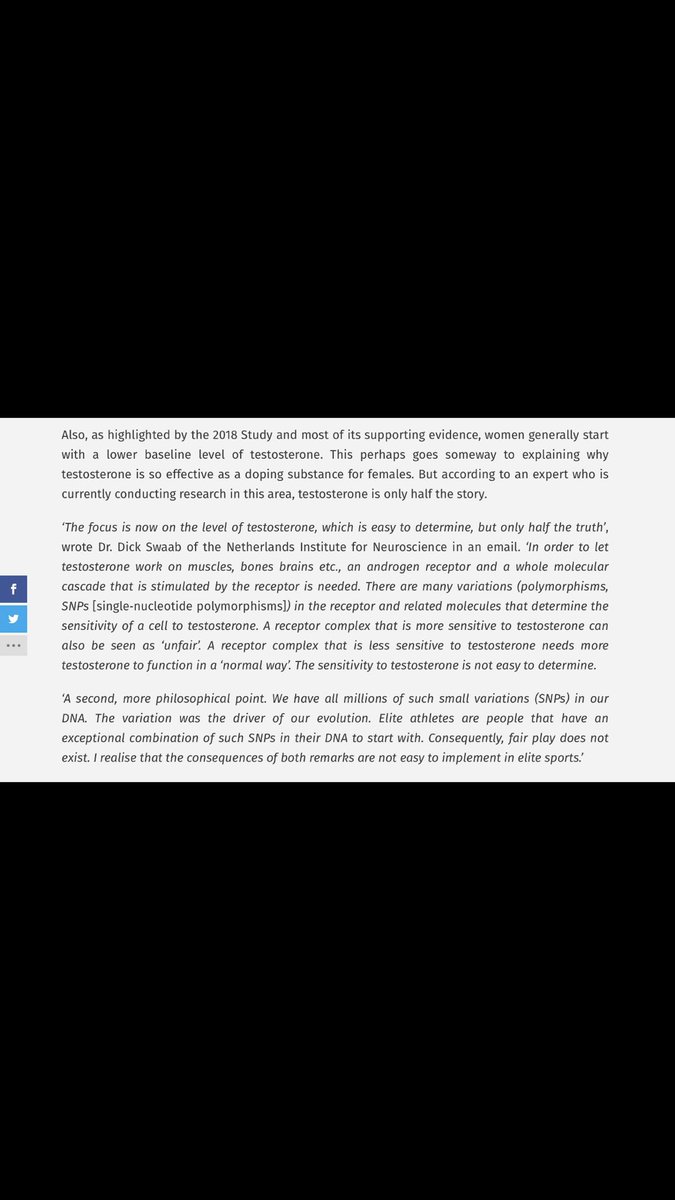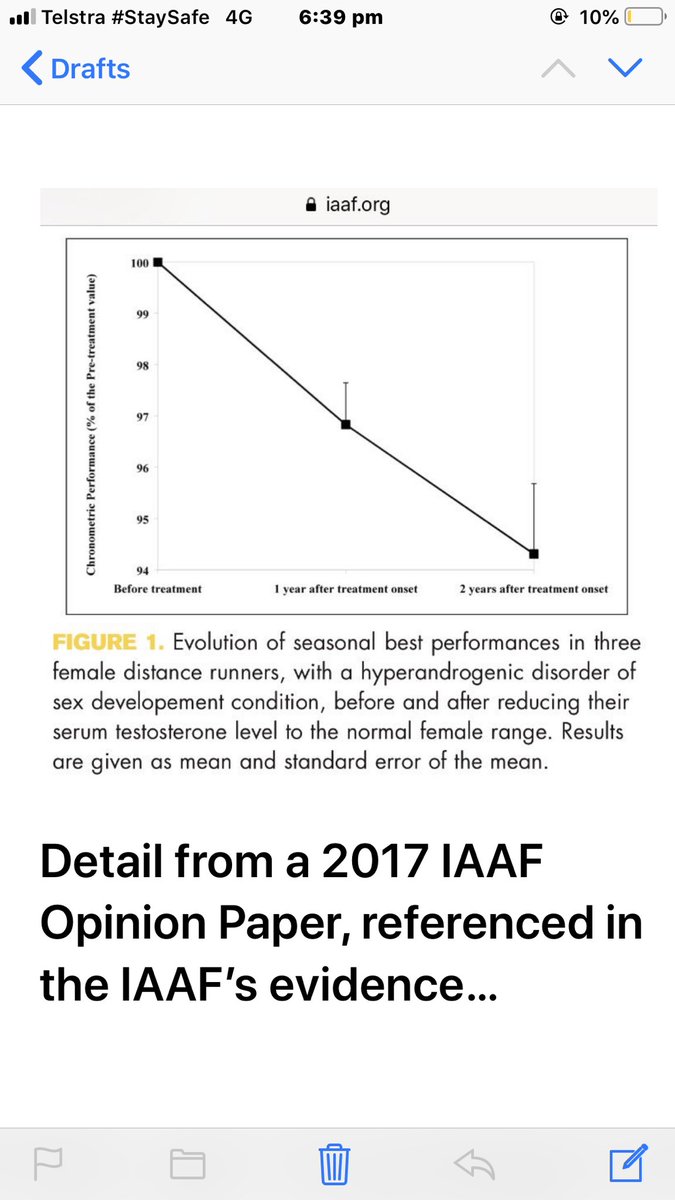The dominant factor in the outcome of any competition is testosterone”, said
@sebcoe President of the @WorldAthletics. If this is true, then it should follow that all cisgender athletes should be covered by regulations in this area & not just trans and DSD women.
@sebcoe President of the @WorldAthletics. If this is true, then it should follow that all cisgender athletes should be covered by regulations in this area & not just trans and DSD women.
Is it fair for a ‘man’ to compete against a ‘woman’? This is one of the most polarising questions in sport at the moment. The emotion that this question generates has sometimes obfuscated any chance of rational debate about what it is that is being regulated and why.
This thread thanks to the amazing research and reporting of @JournoAndy
is designed to clarify this question.
is designed to clarify this question.
The reason that ‘man’ and ‘woman’ are in parenthesis is because gender is not as binary as sport would like it to be in order to easily put athletes into its ‘male’ and ‘female’ categories.
There are men who identify as women, women who identify as men, men who have had surgery to become women, women who have had surgery to become men, and others whose unique physiology means that they do not easily fit in with how sport defines a ‘man’ and a ‘woman’.
As sport created the ‘male’ and ‘female’ categories, this is sport’s problem to solve. It has to find a way of defining who is eligible to compete in its ‘male’ and ‘female’ categories. Sport argues that its ‘female’ category is ‘protected’, but its ‘male’ category isn’t.
Sport has therefore made this a female sport issue, and it has chosen to define who is eligible for female sport based on measuring testosterone levels in serum.
Nobody is arguing that sport should abandon its female category. Nor does it necessarily follow that unless sport can assert a testosterone limit for some female athletes as scientifically, medically, and ethically correct,then sport will be forced to abandon the female category.
Nor does it follow that because men arguably have a performance advantage over women, transgender women will overrun female sport.
Sport has put forward this argument in an attempt to present an apoplectic alternative that it asserts will spread its dark shadow over sport unless it is allowed to regulate testosterone.
The suggestion is offensive to both male and female athletes, through the implication that athletes would be prepared to abandon their true gender identity if it meant they could win.
Such arguments used to be proffered in support of tougher anti-doping – i.e. that athletes would take anything if it helped them win. Not only has this now been debunked, but we also know that at least between 40% and 45% of positive tests (possibly more) are inadvertent.
To argue that transgender women will overrun female sport gives the appearance that sport is trying to avoid any debate by suggesting that unless it can regulate its female category through limits on testosterone, a ‘gender apocalypse’ will happen.
To put forward such arguments appears to be yet another ‘dead cat’ tactic, designed to create outrage in order to stop rational discussion.
Not a single transgender athlete has won an Olympic medal in female sport. Dr. Ivy McKinnon became the first trans athlete to win a world title and set a World Record in October 2018, when she won the UCI Masters Track Cycling World Championships.
However, as she explained to Velonews, this was not by virtue of her testosterone levels, since she produces almost no testosterone. https://www.cyclingnews.com/news/mckinnon-is-first-transgender-woman-to-win-world-title/
Sport’s attempt to set a testosterone limit for some athletes that wish to compete in its female category is not a binary ‘male vs. female’ issue, as many assume. It concerns many separate physiologies that, arguably, shouldn’t be grouped together or regulated in the same way.
The testosterone that these separate physiologies receive is processed differently by each, and therefore does not necessarily equate a performance advantage. Global sports are comparing apples to oranges.
Sport allows other separate physiologies to take synthetic testosterone beyond that which is required to equate normal health. This is the achilles heel which those who argue that sport’s regulations in this area are sexist should focus on in order to support their argument.
Before attempting to define transgender female athletes, in very general terms, females have two types of the same chromosome (XX) and males have two distinct chromosomes (XY). However, at least nine different variations on this basic theme are possible.
https://www2.palomar.edu/anthro/abnormal/abnormal_5.htm
https://www2.palomar.edu/anthro/abnormal/abnormal_5.htm
Testosterone is an androgenic hormoneand is the dominant sex hormone in males (oestrogen in females). However, it is produced by both males and females – often in higher quantities by elite athletes, as it aids muscle growth and recovery.
https://en.wikipedia.org/wiki/Androgen
https://en.wikipedia.org/wiki/Androgen
Females produce it in the ovaries and the adrenal gland, whilst men produce it in the adrenal gland and testes.
https://en.wikipedia.org/wiki/Sex_steroid
https://en.wikipedia.org/wiki/Sex_steroid
Exogenous, or synthetic testosterone is prohibited in sport because the human physiology cannot distinguish between testosterone that it produces naturally (endogenously), and exogenous testosterone.
In very simple terms, somebody who receives exogenous testosterone is getting a boost, because their body is processing and benefitting from extra testosterone that their body didn’t produce. This is understood to be why it is effective as a doping agent.
Whether one can compare the performance of an athlete who has been given exogenous testosterone to take them up to the equivalent testosterone levels of an athlete with high endogenous testosterone remains to be seen.
Such a comparison is potentially problematic, because the athlete given exogenous testosterone is getting a boost, whereas the athlete with high endogenous testosterone is not. High levels of endogenous testosterone are what their physiology is accustomed to.
Androgens such as testosterone are understood to the primary driver for protein cell synthesis in the XY phenotype. In the XX phenotype, the equivalent primary driver is understood to be growth hormone, produced in the liver.
Protein cell synthesis is understood to be the process whereby the human body produces new red blood cells, muscles and ligament tissue.
As testosterone is the primary driver for protein cell synthesis in the XY phenotype, it is understood that somewhere between six and ten times the amount of testosterone is required by the XY phenotype compared to the XX phenotype to enable this process.
If you reduce endogenous T to below what an athlete is accustomed to, there is a concern that protein cell synthesis could be affected. In some phenotypes, this affect can be more pronounced than others. More on that and the potential health problems it can cause later.
1. Transgender female athletes
The Oxford Dictionary refers to a transgender person ‘whose sense of personal identity and gender does not correspond with their birth sex’. This definition encompasses both pre-operation and post-operation trans people.
The Oxford Dictionary refers to a transgender person ‘whose sense of personal identity and gender does not correspond with their birth sex’. This definition encompasses both pre-operation and post-operation trans people.
For the purposes of this thread, transgender female athletes are considered to be XY phenotype that have not undergone gender reassignment surgery.
2. Transitioned female athletes
For the purposes of this thread, ‘transitioned’ female athletes are XY phenotype athletes who have undergone gender reassignment surgery. This involves an orchiectomy – i.e. removal of the testes.
For the purposes of this thread, ‘transitioned’ female athletes are XY phenotype athletes who have undergone gender reassignment surgery. This involves an orchiectomy – i.e. removal of the testes.
Transitioned’ female athletes that have undergone gender reassignment surgery must take synthetic testosterone, otherwise they can suffer serious health implications.
https://www.sportsintegrityinitiative.com/sports-gender-policies-an-affront-to-human-rights/
https://www.sportsintegrityinitiative.com/sports-gender-policies-an-affront-to-human-rights/
Transitioned female athletes suffer health issues unless they take synthetic T, whereas transgender female athletes do not. This is because transitioned female athletes have had their primary source for protein cell synthesis the testes – removed & transgender athletes have not.
As previously mentioned, testosterone plays a vital role in stimulating protein cell synthesis in the XY phenotype, helping to produce new red blood cells, muscles and ligament tissue. If testosterone is limited in both transgender and transitioned athletes,..
..protein cell synthesis is likely to be affected and, consequently, so is the body’s ability to produce new red blood cells, muscles and ligament tissue.
Of course this will affect sporting performance over time, as the physiology of the athlete concerned adjusts to new, lower levels of testosterone.
It may also affect health, and can cause symptoms similar to those experienced by Kristen Worley, a Canadian former cyclist, if testosterone limits are set too low for the XY phenotype, as they were in her case. https://www.sportsintegrityinitiative.com/questions-remain-iaaf-differences-sex-development-regulations/
3. DSD athletes
Athletes with a Difference of Sex Development (DSD), a term that entered sporting consciousness when the IAAF submitted Regulations to the Court of Arbitration for Sport (CAS)...
Athletes with a Difference of Sex Development (DSD), a term that entered sporting consciousness when the IAAF submitted Regulations to the Court of Arbitration for Sport (CAS)...
after it suspended its previous Hyperandrogenism Regulations, are neither transgender or transitioned. https://www.sportsintegrityinitiative.com/application-iaaf-hyperandrogenism-regulations-remains-suspended/
Ms Semenya was born, raised and has participated in athletics as a woman, and identifies as a woman’, read a recent statement from Athletics South Africa (ASA) regarding Caster Semenya’s challenge to the DSD Regulations at CAS. https://www.sportsintegrityinitiative.com/asa-not-amused-of-agreement-breaches-in-case-before-cas/
‘The Regulations attempt to classify her & other female DSDs as “biologically male” or as having a male “sports’ sex”. The Regulations are nothing other than a further attempt (like other scientifically discredited attempts in the past) at so called gender verification testing.’
The Regulations seek to permit athletes with one of seven listed DSDs to compete in events run between 400m and one mile in its female category.
It could be argued that by promulgating the DSD Regulations, the IAAF has inadvertently created a third category of competition, something that Sebastian Coe, its President, said it hadn’t intended. https://www.sportsintegrityinitiative.com/sebastian-coe-defends-iaafs-dsd-regulations/
The very fact that the Regulations exist, as well as their title, calls into question whether DSD athletes are ‘female’. This is something with which the UN Human Rights Council (UNHRC) has taken issue. https://www.sportsintegrityinitiative.com/semenya-will-not-be-eligible-for-doha-unless-she-wins-cas-case/
It is also important to point out that the IAAF is regulating the natural physiology that DSD athletes are born with. This is also the case for transgender athletes, but not transitioned athletes, who have changed their natural physiology through surgery.
4. Female athletes
“The dominant factor in the outcome of any competition is testosterone”, said Sebastian Coe, President of the @WorldAthletics https://www.sportsintegrityinitiative.com/sebastian-coe-defends-iaafs-dsd-regulations/
“The dominant factor in the outcome of any competition is testosterone”, said Sebastian Coe, President of the @WorldAthletics https://www.sportsintegrityinitiative.com/sebastian-coe-defends-iaafs-dsd-regulations/
If this is true, then it would appear to follow that ‘female’ athletes should be covered by regulations in this area.
If sport is going to regulate the levels of testosterone permitted in transgender, transitioned and DSD athletes, then fairness dictates that it must also regulate the amount of testosterone permitted in female athletes.
At present, only transgender, transitioned, and DSD athletes are subject to testosterone limits if they want to compete in certain female sport categories.
5. Male athletes
Likewise, if testosterone offers the huge advantage that sport claims it does, then it should follow that male athletes are also subject to such limits.
Likewise, if testosterone offers the huge advantage that sport claims it does, then it should follow that male athletes are also subject to such limits.
They are not, as sport argues that the male category isn’t ‘protected’, and is therefore not subject to any physiological restrictions. The playing field isn’t level. https://www.sportsintegrityinitiative.com/lie-level-playing-field-civil-immunity-wada-matters/
6. Transgender male athletes
Transgender male athletes are considered to be XX phenotype athletes who view their true gender identity as male. For the purposes of this thread, they are considered to be XX phenotype athletes who have not undergone gender reassignment surgery.
Transgender male athletes are considered to be XX phenotype athletes who view their true gender identity as male. For the purposes of this thread, they are considered to be XX phenotype athletes who have not undergone gender reassignment surgery.
7. Transitioned male athletes
Transitioned male athletes are XX phenotype athletes who have undergone gender reassignment surgery. This can involve a bilateral mastectomy (removal of the breasts), chest contouring, ...
Transitioned male athletes are XX phenotype athletes who have undergone gender reassignment surgery. This can involve a bilateral mastectomy (removal of the breasts), chest contouring, ...
genital reconstructive procedures (GRT) and/or a hysterectomy (removal of internal sex organs).
https://en.wikipedia.org/wiki/Sex_reassignment_surgery_(female-to-male)
https://en.wikipedia.org/wiki/Sex_reassignment_surgery_(female-to-male)
Testosterone: what’s good for the goose…
As highlighted above, we have at least seven separate physiologies that are covered by regulations in this area. Some of them are regulated in the same way, and some are not.
As highlighted above, we have at least seven separate physiologies that are covered by regulations in this area. Some of them are regulated in the same way, and some are not.
Transgender and transitioned female athletes are covered by the @iocmedia Transgender Guidelines, published in 2016. These mandate that in order to compete, transgender & transitioned female athletes must reduce their testosterone levels in serum to below 10 mol/L for 12 months.
This time can be extended on a case by case basis more time is needed to minimise any advantage in the womens competition.
DSD athletes are covered by the ‘Eligibility Regulations for the Female Classification (Athletes with differences of sex development (DSD))’.
The DSD Regulations regulate athletes with one of seven listed DSDs competing in international events run between 400m and one mile in the IAAF’s female category.
They apply to women with one of seven listed DSDs that have naturally occurring testosterone above 5nmol/L that compete in one of the seven listed events, if that testosterone has an ‘androgenising effect’.
Such women must reduce their testosterone to below 5 nmol/L for six months and maintain it at that level in order to be eligible for international competition.
Female athletes that do not have one of the seven conditions outlined in the DSD Regulations and do not compete in events run between 400m and one mile are permitted to compete freely, even if their testosterone levels are above 5 nmol/L.
Male athletes are permitted to compete freely whatever their testosterone levels. As mentioned previously, the IAAF’s position is that this is because it only considers the female category ‘protected’, and not the male category. https://www.sportsintegrityinitiative.com/world-experts-supporting-iaafs-eligibility-regulations-for-athletes-with-dsd-at-the-cas-this-week/
As mandated by the IOC’s Transgender Guidelines, female to male athletes who wish to compete as men are allowed to compete ‘without restriction’. This has created a category of athletes who might be considered to be legitimately doping.
As part of their transition to become male, XY phenotype athletes very often undergo hormone treatment with testosterone, irrespective of whether they undergo sex reassignment surgery.
A 2018 Study produced for the IAAF in support of the DSD Regulations, which was not published when the IAAF promulgated them, concedes that androgen receptors may be more sensitive in the XX phenotype.
There is also anecdotal evidence that the dose-response curves may be left shifted so that testosterone has greater potency in women than in men at comparable doses and circulating levels’,
It is understood that this sensitivity to testosterone in the XX phenotype is the reason that doping with testosterone has been so successful in female sport.
In summary, male to female athletes have had their primary source for protein cell synthesis reduced, and are forced to limit this in order to compete.
Female to male athletes retain their primary source for protein cell synthesis, but are permitted an additional exogenous dose of testosterone, which the IAAF concedes may benefit the XX phenotype more than the XY phenotype.
It is not difficult to see why some arguethat this is legitimised doping.
https://www.sportsintegrityinitiative.com/worleys-case-opens-courts-athlete-human-rights-cases/
https://www.sportsintegrityinitiative.com/worleys-case-opens-courts-athlete-human-rights-cases/
Proving performance advantage
This brings us back around to performance advantage. Pressure groups have been set up arguing that trans women should be prohibited from competing against women, and scientists have explained that a performance advantage exists between women and men.
This brings us back around to performance advantage. Pressure groups have been set up arguing that trans women should be prohibited from competing against women, and scientists have explained that a performance advantage exists between women and men.
However, are people asking the right question?
Both the IOC and the IAAF base their regulations in this area on levels of endogenous testosterone.
Both the IOC and the IAAF base their regulations in this area on levels of endogenous testosterone.
As such, shouldn’t the be asking whether higher endogenous testosterone does give an athlete an advantage and if so, is this advantage unfair when compared to other physiological variables (height, weight, lean muscle mass, stride length)?
The ASA statement relating to Semenya’s case suggests that the IAAF has again been unable to prove that endogenous testosterone does confer an advantage. https://www.sportsintegrityinitiative.com/asa-not-amused-of-agreement-breaches-in-case-before-cas/
The evidence proffered by the IAAF in support of the DSD Regulations suggeststhe same conclusion.
https://www.sportsintegrityinitiative.com/caster-semenyas-challenge-to-the-dsd-regulations-its-complicated/
https://www.sportsintegrityinitiative.com/caster-semenyas-challenge-to-the-dsd-regulations-its-complicated/
‘The sensitivity of the body to testosterone is at least as important as the level of testosterone’, writes Dr. Dick Swaab, Professor of Neurobiology at the University of Amsterdam.
‘There are genetic variations in the testosterone receptor that determine this sensitivity. This variation has never been studied in relation to sport. Without knowledge on the sensitivity for testosterone, measurement of testosterone levels is meaningless.’
This statement is supported by Peter Sönksen, a former Professor of Endocrinology at St. Thomas’s Hospital and King’s College. ‘Testosterone is no more important than growth hormone’,.
Also, there is difficulty in people understanding that athletes with androgen resistance who are born and raised as girls have such resistance to testosterone that they cannot benefit from it as a performance enhancing agent’.
Nobody is saying that men don’t enjoy a performance advantage over women. In most cases they do, although it is significant that in some sports, such as sailing, men and women compete against each other on equal terms.
But if sport is going to use endogenous testosterone as a determinant of unfair advantage in female sport, it has to prove that it does give athletes an unfair advantage in female sport.
Sport can regulate gender and most people clearly want it to do so. What people don’t want is unfairness. And due to sport’s regulations in this area, that’s exactly what we have at the moment.
XY phenotype athletes who transition to compete in the female category face restrictions on their natural physiology, as do DSD athletes.
XX phenotype athletes who transition to compete in the male category are able to do so without restriction, and are permitted to dope with testosterone.
This isn’t the level playing field that sport so often holds up as a paragon of virtue. The argument put forward by sport is that only the female category is protected but not the male category, which is unrestricted.
This assertion that the competitive advantage held by XY men is insurmountable could come back to haunt sport. As gender transition becomes more acceptable in wider society...
(many schools now have gender neutral toilets), more XX men are going to compete in male sport in the future. XX women who transition to compete in male sport are receiving a boost of testosterone that has an effect equivalent to that received by an athlete who is doping.
These XX ‘supermen’ are going to start outperforming XY men, and allegations of legitimised doping will emerge. More ‘negative gender stereotypes’ will be reinforced to borrow the UN’s words and more people will be harmed.
Grotesque
Athletes have already been harmed. One example is Kristen Worley, who sufferedhealth consequences from being forced to lower her testosterone to 0.5 mol/L in order to compete – much less than that required by her XY phenotype.
Athletes have already been harmed. One example is Kristen Worley, who sufferedhealth consequences from being forced to lower her testosterone to 0.5 mol/L in order to compete – much less than that required by her XY phenotype.
Another example involves four young athletes (18, 20, 20 and 21) who were told, ahead of the London 2012 Olympics, that a gonadectomy (removal of undescended testicles) would be likely to lower their testosterone levels and allow them to compete in the IAAF’s female category.
The four athletes were also given feminine remodelling surgery that had nothing to do with this. ‘We thus proposed a partial clitoridectomy with a bilateral gonadectomy, followed by a deferred feminizing vaginoplasty and estrogen replacement therapy, to which the 4..
athletes agreed after informed consent on surgical and medical procedures’, reads the Study. ‘ https://academic.oup.com/jcem/article/98/6/E1055/2536727
Sports authorities then allowed them to continue competing in the female category 1 year after gonadectomy’. The above is a nice way of saying that the four athletes were subject to partial clitoral amputation and surgical widening of the vagina.
The IAAF has previously denied suggesting such surgery to the athletes concerned. However the above Study reveals that the surgery was proposed to athletes, and one of the doctors involved is Stéphane Bermon, Director of the IAAF Health and Science Department.
Given that such surgery was suggested to young athletes in a context where sport was outlining that they would not be eligible to compete as a woman, there are serious questions as to whether the athletes freely consented to such surgery.
Concerns have also been raised as to whether such consent was fully informed. It is understood that many who have such surgery later regret it, and that there can be side effects to such surgery, which do not appear to have been mentioned in the above Study.
It could also be argued that by offering gender remodelling surgery to such young athletes, the doctors involved robbed them of a choice to make a decision about their own gender.
Such a choice was also denied to former German Democratic Republic athletes who were doped with testosterone under State Plan 14.25, which can affect gender development.
https://en.wikipedia.org/wiki/Doping_in_East_Germany
https://en.wikipedia.org/wiki/Doping_in_East_Germany
My decision to discover my gender was taken from me”, says Andreas Kreiger in the below documentary. It could be argued that the four young female athletes have suffered the same fate.
What is even more grotesque is that the IAAF has used analysis of some of the times of these four young athletes, who also had oestrogen replacement therapy, as evidence that reducing testosterone in DSD athletes decreases their performance.
The @WorldAthletics used their case as evidence in support of the DSD Regulations.
https://www.sportsintegrityinitiative.com/caster-semenyas-challenge-to-the-dsd-regulations-its-complicated/
https://www.sportsintegrityinitiative.com/caster-semenyas-challenge-to-the-dsd-regulations-its-complicated/
It could legitimately be argued that anyone who undergoes such a life changing experience is likely to show a decrease in performance. However, whether this decrease in performance is due to reduced testosterone or psychological scars is subject to significant debate.
It would therefore appear that despite the IAAF’s criticism, the UNCHR’s request that States ensure that sporting bodies ‘refrain from developing and enforcing policies and practices that force, coerce or otherwise pressure woman and girl athletes into undergoing unnecessary,..
humiliating &harmful medical procedures in order to participate in women’s events in competitive spots, and to repeal rules, policies & practices that negate their rights to bodily integrity & autonomy’ is well placed.
Which is perhaps why the IAAF sought to rewrite the DSD Regulations after the CAS hearing. The delay in handing down the CAS award was entirely due to the IAAF seeking to amend the Regulations post the CAS hearing’, read the recent statement from the ASA, https://www.sportsintegrityinitiative.com/asa-not-amused-of-agreement-breaches-in-case-before-cas/
ASA expressing its dissatisfaction that the IAAF had repeatedly breached an agreement to keep Semenya’s case closed and confidential, an agreement which the ASA said it had been pressured into against its will.
Keeping the case closed and confidential whilst issuing statements in support of the DSD Regulations appears to be a tactic designed to control the narrative around the case.
CAS allowed the IAAF to submit new Regulations (it allowed submission of the DSD Regulations to terminate Dutee Chand’s case against its previous Hyperandrogenism Regulations) rather than issuing a definitive final ruling against the IAAF.
This lends support to the argument that the CAS is too closely tied to the sports bodies that fund it.
As the ASA has pointed out, the IAAF failed to demonstrate that endogenous testosterone above 5 nmol/L provides such an unfair performance advantage in female sport that it is necessary to exclude athletes from events run between 400m and one mile.
Dutee Chand, who challenged the IAAF’s previous Hyperandrogenism Regulations, is a 100m sprinter. Why focus on those events in particular?
The effects are most clearly seen in races over distances between 400m and one mile, where the combination of increased lean body mass and elevated circulating haemoglobin appears to have the greatest combined impact’, arguesJonathan Taylor,...
who drafted the DSD Regulations for the IAAF and the Transgender Guidelines for the IOC. https://www.sportsintegrityinitiative.com/iaaf-response-article-differences-sex-development-regulations/
However, other physiological variables (such as height) provide a similar advantage to that asserted by the IAAF in other events, as explained Should we regulate them as well?
If so, where does this stop before we end up with a series of classifications as exists in Paralympic sport and the subsequent ‘classification cheating’ allegations that have emerged?
The only solution is to start again. If sport wants to separate men and women, then it has to find a better way than simply measuring testosterone levels in serum.
And here’s a controversial point. It has been suggested that self-identification would be ‘crazy’, and would lead to the disappearance of women from sport.
As mentioned in the introduction, this assumes that athletes are so bent on winning that they would be prepared to abandon their gender identity to do so. There has simply not been any research about whether this is the case, and a scientific athlete survey is a project...
that social scientists should seriously consider undertaking. We may be seriously overestimating this potential problem.
I would also urge anyone who considers that an advantage persists for XY phenotype athletes competing in female sport to read about the procedures that transition involves, and seriously consider whether such an advantage would persist, for example, two years after transition.
To borrow the IAAF’s terminology, ‘evidence from the field’ – i.e. from athletes who have made the transition – suggests that it may not. Unless, of course, you are an XX phenotype athlete taking exogenous testosterone and competing in male events.
As the UN points out, this is a human rights issue, and sport cannot have rules that call into question international human rights standards and norms.
End
End
@threadreaderapp please unroll if not too late.

 Read on Twitter
Read on Twitter